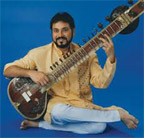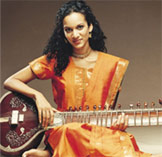SITAR
Sitar is one of the most popular Indian classical instruments and it comes under the category of a chordophone in the lute family. Sitar has neck crafted from toon or teakwood and a resonator carved from a large seasoned gourd. The modern sitar has seven strings and sixteen to twenty two frets that are adjusted to alter the pitch.
A normal Sitar usually has Kunti, Drone Strings, Tumba, Tar, Dandi, Parda, Gulu, Tuning beads, Kaddu. It is played with a wire plectrum, known as mizrab, that is usually worn on the index finger of the right hand.
The sitar had become prominent by the mid nineteenth century. It is an instrument with long hollow neck and gourd body produces a rich resonance and harmony, and is the dominant instrument used in Hindustani classical music and is played as an accompaniment to dance throughout India and Pakistan. Sitar Music is ubiquitous in other Middle Eastern countries as well.
Introduction

The construction of a quality sitar has always been a complex process. Such instruments usually are often crafted by sitar 'makers' or 'fitters'. The neck, faceplate, and gourd of the finely-crafted sitar are typically constructed of a combination of mahogany and teak wood, which is known as toon wood, and its bridges are made from various materials such as deer horn, ebony, or even camel bone, although synthetic materials are also used, often to lesser effect. Expert sitar builders string the instrument with help of a bridge through jawari, and then let the instrument sit for a week or so to allow the neck to bend slightly. This is done so that it settles before the sympathetic peg holes are drilled and ensured that the fret setting is correct.
Sitar music is considered to be emotional and should be played in a heartfelt manner. Ravi Shankar is one of the most famous sitar players familiar to the western world. He taught George Harrison of The Beatles how to play the sitar and Harrison played the instrument in at least three Beatles songs including Norweigan Wood. Other rock groups such as The Rolling Stones and Metallica have sitar music in several of their songs.
Sitar is an instrument which is long necked with an interesting construction with the strings. It has a varying number of strings 17 is usual. It has three to four playing strings and three to four drone strings. The approach to tuning is somewhat similar to other Indian stringed instruments. These strings are plucked with a wire finger plectrum called mizrab. There are also many series of sympathetic strings lying under the frets. These strings are almost never played but they vibrate whenever the corresponding note is sounded. The frets are metal rods which have been bent into crescents. The main resonator is usually made of a gourd and there is sometimes an additional resonator attached to the neck.
Popular Musicians
 Some famous sitar players are Ustad Vilayat Khan, Pt. Ravishankar, Ustad Imrat Khan, Ustad Abdul Halim Zaffar Khan, Ustad Rais Khan and Pt Debu Chowdhury.
Some famous sitar players are Ustad Vilayat Khan, Pt. Ravishankar, Ustad Imrat Khan, Ustad Abdul Halim Zaffar Khan, Ustad Rais Khan and Pt Debu Chowdhury. How to play a Sitar
Sitar master Shri Ashwin Batish gives out the very basics for playing the Sitar. Half-lotus Sitting Position should be used. The Top strings and the Sympathetic strings should be tuend properly. There is also a particular fashion in which the sitar frets should be moved.Where to learn to play a Sitar
Saraswati Music College011 26167911, 011 26105611
A-1/226 , Safdarjung enclave near Kamal Cinema
Vocal, Instrument
[email protected]
www.saraswatimusiccollege.com
Delhi Music Society
Music Class , Cultural Centre
011 24121058 , 011 26115331
8, Nyaya Marg , Chanakya Puri , Delhi- 110045 Near Chinese Embassy
www.delhimusicsociety.com
Where to buy a Sitar
Sathyadeep Musical PalaceContact: Mr Ashish Shrivastava
Beside Vysya Bank
Post- Puttaparthy
Dist-- Anantapur
Andhra Pradesh Pin- 515134
INDIA
[email protected]
[email protected]
Rain City Music
20825 State Route 410 E
#270 Bonney Lake,
WA 98391
USA Phone: 253-678-2605
Phone hours are 8am to 8pm weekdays, 10am to 7pm weekends
Email: [email protected] 24 hours/day


